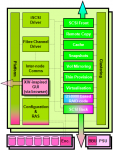Surprise! Huawei Symantec has arrived in the United States, ready to take on the midrange storage and network security market with a line of devices that have proven their worth in the international market for three years. I sat down with the company’s management at Storage Networking World and quizzed them on their plans and aspirations for growth.
Gestalt IT
IBM’s Storwize V7000: 100% SVC; 0% Storwize
Today, IBM alerted the world that they had not fallen asleep at the wheel by kicking out an awfully-impressive midrange storage array, the Storwize V7000. This seems like an excellent device, filled with proven engineering borrowed from the successful SAN Volume Controller (SVC) line of storage virtualization products. But closer examination (and IBM’s own Tony Pearson) reveal that it contains exactly nothing from their Storwize acquisition apart from the name.
Is NFS v3 Really That Bad?
Did some pNFS proponent slip a love potion into the coffee at EMC? Suddenly it’s pNFS time at the company known for its reluctance to embrace file sharing and filesystems in general. The purple prose is flying, with Chad Sakac declaring himself “a big fan of the application of NFS” and Chuck Hollis extolling the “inherent simplicity and ease-of-management of NFS.” The NetApp guys must be amused by the bear hug from Hopkinton, but many are seeing deja-vu all over again.
CommVault Simpana 9 Takes Backup To A New Level
CommVault is one of those enterprise IT companies that likes to go their own way. A spin-out of AT&T’s famed Bell Labs, CommVault’s Simpana software integrates many aspects of data management, from backup to e-discovery, under one umbrella. Last year, the company impressed me by adding cloud storage as a backup target equal in status to disk and traditional tape. Now the company is doing the same for storage-based snapshots, accelerating data protection for virtual machines.
Four Fundamental Best Practices for Enterprise IT
Although many people are cynical about the whole idea of best practices, I’m a believer. I think that such beasts do exist, just that too many companies, analysts and especially consultants spend too much time applying the label to whatever works in their best interest at the time. To counteract this cesspool of non-best practices, I thought it best to put down a few ideas of my own. Following are four fundamental best practices I have distilled from almost 20 years in enterprise IT. I wonder if you agree with them.




